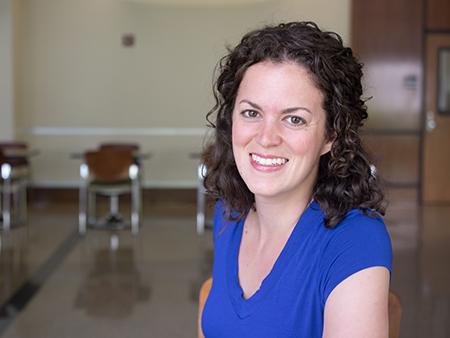Media contact: Yvonne Taunton
Editor's Note: The information published in this story is accurate at the time of publication. Always refer to uab.edu/uabunited for UAB's current guidelines and recommendations relating to COVID-19.
 Mieke Beth Thomeer, Ph.D., and Jenjira Yahirun, Ph.D., discuss how families influence health and health disparities throughout life’s course and during COVID-19.Families are central to our experience of COVID-19, and they can serve as a mechanism that either exacerbates or reduces the health and economic inequalities our society is currently facing.
Mieke Beth Thomeer, Ph.D., and Jenjira Yahirun, Ph.D., discuss how families influence health and health disparities throughout life’s course and during COVID-19.Families are central to our experience of COVID-19, and they can serve as a mechanism that either exacerbates or reduces the health and economic inequalities our society is currently facing.
Mieke Beth Thomeer, Ph.D., associate professor in the College of Arts and Sciences’ Department of Sociology at the University of Alabama at Birmingham, and Jenjira Yahirun, Ph.D., assistant professor of sociology at Bowling Green State University, say as sociologists who study health and families, this is nothing new.
Thomeer summarized research in this area in a recent review article with Debra Umberson, professor of sociology at the University of Texas at Austin, in the Journal of Marriage and Family, for which Thomeer is a deputy editor.
Decades of studies demonstrate that families matter for health; but being single, having kids or caring for a parent feels especially consequential during this time. This is reflected in several proposed policies and recommendations, say Thomeer and Yahirun.
States tell citizens to shelter in place and clarify this means that one should only be in contact with their immediate household, not driving across town to visit their mother. The economic relief package includes more money for married couples who file taxes jointly and additional funding for their children. Employers who demand that their employees work full time from home expect that child care duties can be given to — or at least shared with — a partner.
These policies are best suited for a specific type of family arrangement: a dual-earner, married couple with college degrees and few caregiving responsibilities.
But this family type is distributed unevenly across the population, contributing to what sociologist Sara McLanahan calls “diverging destinies.” People with more economic resources and educational attainment tend to be in family arrangements that experience less instability and provide more social, emotional and financial support.
Thomeer and Yahirun say these families can shore up resources that can help them withstand unexpected crises, like a pandemic. Yet too much focus on the nuclear family provides an incomplete picture of family life. In 2010, only one in five United States households included married couple households with children. Policies and recommendations made with this group in mind only serve to exacerbate health and economic inequalities.
What can be done to position families as valuable resources for reducing inequality and benefiting the health and economic well-being of all, not just the dual-earner nuclear family?
 Mieke Thomeer, Ph.D., associate professor in the Department of Sociology in the College of Arts and SciencesFirst, Thomeer and Yahirun suggest expanding who we think of as part of our own family and who government policies recognize as a family. This involves accepting broader definitions of who counts as kin, building on concepts of the chosen family, fictive kin, and forged families that go beyond biological or legal ties.
Mieke Thomeer, Ph.D., associate professor in the Department of Sociology in the College of Arts and SciencesFirst, Thomeer and Yahirun suggest expanding who we think of as part of our own family and who government policies recognize as a family. This involves accepting broader definitions of who counts as kin, building on concepts of the chosen family, fictive kin, and forged families that go beyond biological or legal ties.
“We see how at the community level broader notions of kinship are playing out as neighbors buy groceries for each other, community members join birthday parades and Zoom happy hours take priority,” according to Thomeer and Yahirun. “These grassroots efforts can be supported by government policies that recognize and financially support the labor involved in providing care to children, older adults and people with illnesses or disabilities — even if that labor isn’t performed by legal family members but by community members.”
Second, we should recognize that some family structures are better able to weather the challenges of this pandemic than others. Nuclear households are more likely to have economic and social resources to provide care for children while attempting to share the responsibilities of child care.
As states and cities have enacted bureaucratic hurdles for accessing benefits, including unemployment and food banks, that require enormous time sacrifices — long lines, multiple phone calls — these challenges stretch thin the capabilities of single parents already struggling with homeschooling children and other duties. Policies aimed at relieving those in need should recognize that the types of family forms that will struggle to meet bureaucratic demands are the same families that need these supports the most.
Third, we must also understand that, because families are frequently the sites of shared information and economic resources, even individuals who are less economically or educationally advantaged can draw on the resources of family members who have more of these resources.
College-educated adult children, for example, may be in better positions to help older parents navigate new health information, assess health care costs or provide temporary monetary transfers. This may matter more for racial and ethnic minorities for whom having a family member without a college education is common, as social mobility rates among communities of color have stagnated in recent decades. Unfortunately, given the current educational crisis, many young adults will likely drop out of college in the coming months and years. But a federal response that encourages young adults already in college to remain enrolled and ensures that college stays affordable has positive health consequences for multiple generations.
As social institutions, families have the potential to either exacerbate or reduce existing disparities. Thomeer and Yahirun say we should aim to create policies and recommendations that support multiple types of family arrangements and that use families as a way to reduce inequalities — not to broaden them.
Thomeer and Yahirun originally featured their opinion Op-Ed via The Hill.